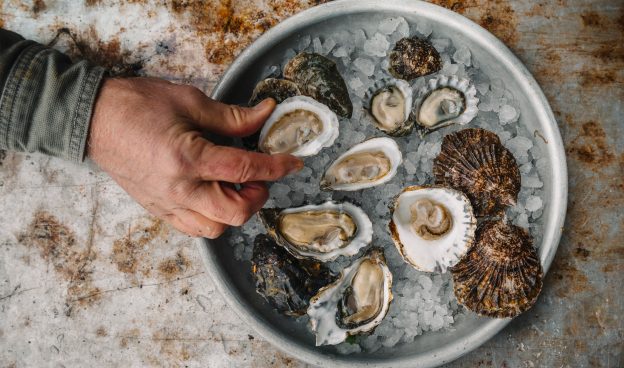Ocean Acidification is particularly concerning in regions — like the California coast — where seasonal upwelling occurs.
Upwelling takes place when strong winds push surface waters away from the shoreline, allowing colder, nutrient-rich water to rise from below. This nutrient-rich water supports diverse populations of marine life. But it is also rich in dissolved CO2 and has a naturally lower pH compared to the water it replaces. There is growing concern that human-caused OA from burning fossil fuels might amplify the acidity of these upwelling areas and be particularly damaging to these sensitive marine ecosystems.
Ecological Impacts
Many Pacific shellfish species are economically and ecologically important. California mussels, oysters and scallops not only hold significant commercial value but are also key organisms of the rich marine ecosystems that extend along the West Coast. Recent studies have shown that these species are highly susceptible to the negative impacts of OA, particularly during their early developmental stages when these animals need carbonate to rapidly build protective shells and other hard structures.
Corals also depend on dissolved carbonate to build their internal skeletons and therefore are particularly susceptible to the harmful effects of OA. Decreasing ocean pH can severely reduce their ability to properly build and maintain their hard composition. Additionally, the reproductive abilities of corals can be significantly harmed. The long-term effects of these changes in ocean chemistry may lead to a decline in the overall health and stability of one of the most diverse and magnificent ecosystems in the world.
More recently, studies have found that increases in the acidity of seawater can produce dramatic behavioral changes in marine animals. One notable example involves clown fish. Under normal pH levels, clown fish stay close to their home base — the coral or anemone in which they live throughout their lives. As the acidity of the water increases, the fish begin to stray farther from their home. As they do so, clown fish are at greater risk of being eaten by predators. A decrease in ocean pH can also impair their sense of smell, thus making it more difficult for the clown fish to detect potential predators within their environment.
Economic Impacts
OA threatens the viability of communities dependent on coastal and ocean-related economies including sport fishing, marine recreation, tourism and trade. Ultimately, livelihoods of people that depend on the ocean will be impacted considerably.
West Coast shellfish growers who make significant contributions to the state and local economies are already feeling the impacts of OA.
Shellfish larvae are particularly sensitive to changes in the pH of seawater. Lower ocean pH has resulted in less available dissolved carbonate, resulting in substantial declines in shellfish survival with the effects already causing severe declines in the production of key shellfish species including oysters, mussels and scallops. Such declines cause substantial revenue losses for aquaculture companies dependent on the health of these species — an important consideration when you realize that the annual value of oyster, clam and scallop harvests are estimated at $400 million in the U.S.
Shellfish growers such as Taylor Shellfish Farms, Coast Seafoods, Whiskey Creek Oyster Farm, Hog Island Oyster Company and Monterey Abalone Company have been actively involved in water quality monitoring efforts and serve as strong advocates for finding sustainable solutions to the challenges brought on by ocean acidification.

